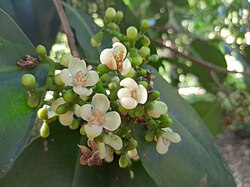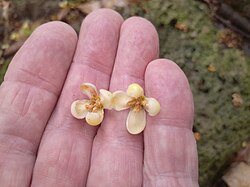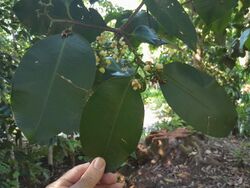Biology:Garcinia warrenii
| Garcinia warrenii | |
|---|---|

| |
| Native mangosteen in flower | |
| Scientific classification | |
| Kingdom: | Plantae |
| Clade: | Tracheophytes |
| Clade: | Angiosperms |
| Clade: | Eudicots |
| Clade: | Rosids |
| Order: | Malpighiales |
| Family: | Clusiaceae |
| Genus: | Garcinia |
| Species: | G. warrenii
|
| Binomial name | |
| Garcinia warrenii | |
Garcinia warrenii, a is a fruit-bearing tree, up to 15 metres in height, of the mangosteen family (Clusiaceae), commonly known as native mangosteen or Warren's mangosteen. It is found in the tropical rainforests of northern and north-eastern Australia and New Guinea. The genus Garcinia, belonging to the family Clusiaceae, includes about 200 species found in the Old World tropics, mostly in Asia and Africa. Garcinia warrenii is indigenous to New Guinea, the Torres Strait Islands, northeastern Queensland from Cape York Peninsula south to Babinda,[1] and a small, isolated population on Melville Island in the Northern Territory, Australia.[2]
Garcinia warrenii is found in rain forest, littoral rainforest and riparian forest from 0 to 780 m.[3]
Uses
There are five species of native Garcinia in north Queensland forests but Garcinia warrenii is the only edible one.[4] While the fruits are edible, they are not widely sought after.[5][6]
Description
Garcinia warrenii is a close relative of the mangosteen (Garcinia mangostana). This bushy small tree grows up to 15 metres high, they grow straight up and are often difficult to see in the forest. It has fragrant white flowers and purple sweet edible fruit. The thick, leathery leaves are often stained with mould or lichens. Broken petioles (leaf stalks) and twigs produce a sticky yellow exudate. Leaf blades are about 10 to 16 x 48 cm. The fruit are eaten by Pteropus (fruit bats).
Further reading
- Fruits of the Australian Tropical Rainforest. 2004. Wendy Cooper; illustrated by William T. Cooper. Nokomis Editions, Melbourne.
- Plants of Cape York: the Compact Guide. John Beasley. 2009.
- Plants of Tropical North Queensland: the Compact Guide. John Beasley. Footloose Publications, Kuranda. 2006.
References
- ↑ "Garcinia warrenii". Commonwealth Scientific and Industrial Research Organisation (CSIRO). https://apps.lucidcentral.org/rainforest/text/entities/garcinia_warrenii.htm.
- ↑ "Threatened Species of the Northern Territory". http://www.lrm.nt.gov.au/__data/assets/pdf_file/0020/10946/Garcinia_warrenii_EN.pdf. Retrieved 4 September 2019.
- ↑ Cooper, Wendy; Cooper, William (2004). Fruits of the Australian Tropical Rainforest. Nokomis Editions. p. 124. ISBN 0-9581742-1-0. https://www.williamtcooper.com.au/books/fruits-australian-tropical-rainforest/.
- ↑ "Rare Fruit Australia » Eat your landscaping » Mangosteen Nutrition Management". http://www.rarefruitaustralia.org/2006/05/25/mangosteen-nutrition-management/. Retrieved 4 September 2019.
- ↑ Plants of Tropical North Queensland: the Compact Guide, p. 90.
- ↑ Beasley, John (2009). Plants of Cape York. John Beasley. p. 154. ISBN 978 0 9806863 0 2.
Wikidata ☰ Q15392803 entry
 |



